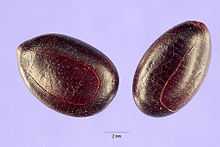Prosopis africana
| Prosopis africana | |
|---|---|
 | |
| Prosopis africana seeds. | |
| Scientific classification | |
| Kingdom: | Plantae |
| (unranked): | Angiosperms |
| (unranked): | Eudicots |
| (unranked): | Rosids |
| Order: | Fabales |
| Family: | Fabaceae |
| Subfamily: | Mimosoideae |
| Tribe: | Mimoseae |
| Genus: | Prosopis |
| Species: | P. africana |
| Binomial name | |
| Prosopis africana (Guill. & Perr.) Taub. 1893 | |
Prosopis africana is a flowering plant species in the genus Prosopis found in Africa. Its common names include African mesquite, iron tree, Gele (Malinke) (traditional djembe wood) or Somb tree.
In the Serer creation myth, it is one of the sacred trees that grew not just first, but also within the primordial swamp on Earth.
Seeds of P. africana are used in Nigeria to prepare daddawa,[1] kpaye[2] or okpeye,[3] fermented products used as food condiments. Several species of bacteria especially Bacillus subtilis, Bacillus licheniformis, Bacillus megaterium, Staphylococcus epidermidis and Micrococcus spp were found to be the most actively involved organisms in the production of okpiye.[4] Sequencing of 16S rRNA genes of selected strains representative of the major clusters revealed that the Bacillus strains associated with okpehe fermentation were B. subtilis, B. amyloliquefaciens, B. cereus and B. licheniformis (in decreasing order of incidence). The presence of enterotoxin genes in all B. cereus strains was demonstrated by multiplex PCR. The high incidence of detection (20%) of possibly pathogenic B. cereus strains that contained enterotoxin genes indicated that these fermented foods may constitute a potential health risk.[5]
The seeds also produce a gum.[6]
The plant produces the alkaloids prosopine and prosopinine.[7]
See also
References
- ↑ Barminas, J.T.; Maina, H.M.; Ali, J. (1998). "Nutrient content of Prosopis africana seeds". Plant Foods for Human Nutrition 52 (4): 325–8. doi:10.1023/A:1008045218320. PMID 10426119.
- ↑ Omafuvbe, B.O; Abiose, S.H; Adaraloye, O.O (1999). "The production of 'Kpaye' – a fermented condiment from Prosopis africana (Guill and Perr) Taub. Seeds". International Journal of Food Microbiology 51 (2–3): 183–6. doi:10.1016/S0168-1605(99)00088-4. PMID 10574093.
- ↑ Obeta, J.A.N.; Ugwuanyi, M.A.A (1996). "Microbiology of the production of okpeye, a condiment from seeds of Prosopis africana Taub". Tropical science 36 (4).
- ↑ Achi, O. K. (1992). "Microorganisms associated with natural fermentation ofProsopis africana seeds for the production of okpiye". Plant Foods for Human Nutrition 42 (4): 297–304. doi:10.1007/BF02194090. PMID 1438073.
- ↑ Oguntoyinbo, FA; Huch, M; Cho, GS; Schillinger, U; Holzapfel, WH; Sanni, AI; Franz, CM (2010). "Diversity of bacillus species isolated from okpehe, a traditional fermented soup condiment from Nigeria". Journal of food protection 73 (5): 870–8. PMID 20501038.
- ↑ Adikwu, MU; Ezeabasili, SI; Esimone, CO (2001). "Evaluation of the physico-chemical properties of a new polysaccharide gum from Prosopis africana". Bollettino chimico farmaceutico 140 (1): 40–5. PMID 11338777.
- ↑ Ratle, G; Monseur, X; Das, BC; Yassi, J; Khuong-Huu, Q; Goutarel, R (1966). "Prosopine and prosopinine alkaloids of Prosopis africana (Guill and Perr) Taub. (Preliminary note)". Bulletin de la Societe chimique de France (in French) 9: 2945–7. PMID 5992092.
External links
| Wikimedia Commons has media related to Prosopis africana. |
| Wikispecies has information related to: Prosopis africana |